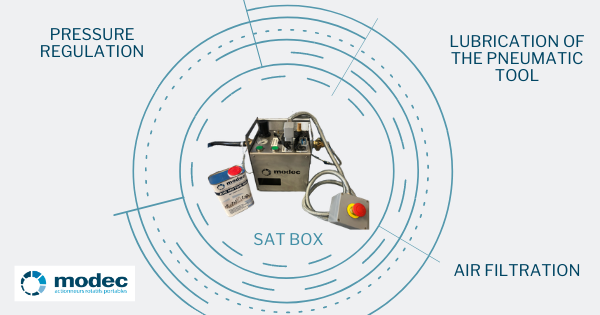
modec Portable Valve Actuators are typically used throughout facilities to operate manual valves. The most common scenario is to have a modec Actuator (Battery, Pneumatic, or Gas Powered) used directly at the valve(s) via the engagement of the actuator to a hand wheel plate adapter, socket, or some other means to temporarily attach the actuator to the valve(s). This approach may include multiple actuators and multiple, different hand wheel plate adapters, sockets, etc., as valves throughout a facility are typically different from valve to valve.
modec has worked with many customers over the years to help address another valve problem with a modec solution-Operating Valves remotely via the use of modec equipment. Systems can be designed to attach an air motor to the valve or valve gearbox. These motors are manufactured by modec, as we have designed air motors for many years for other applications such as mixing machines, etc. This motor is then powered via air (pneumatic) from a control box (designed and supplied by modec), which can be several feet or many feet away from the valve.
.jpg?width=768&height=923&name=GRT%20Gaz%20e%CC%81vent%20-%20MTZ08%20-%20BP002%20(2).jpg)
- An inlet connection point to connect the air supply line to the control box
- An on/off switch to control the flow of air to the air motor mounted at the valve
- Hose to connect the control box to the air motor at the valve. This requires to runs of hose, so that the valve can be remotely operated in either direction
- A directional switch that controls which hose the air is flowing through
- A filter, regulator, lubricator. The filter cleans the air supply going to the motor, the lubricator provides oil, via the air line, to the motor at the valve. The regulator controls the air pressure and is adjustable.
A cut off switch that can be activated should the air supply be interrupted. This will bleed the air out of the downstream system, so no residual energy is present and no accidental motion can occur.
There are many reasons why personnel would prefer to activate a valve remotely. In this section, we will talk about many of the reasons why.
Many times, the temperature is very high directly at or near the valve. Exposure to high temperatures can be hazardous for the operator causing perspiration, leading to dehydration. The high heat in the area near the valve can cause further hazards, as any equipment the operator might touch in the area could cause a burn. This might include the valve hand wheel.
Utilizing a remote valve operating system can minimize risk by removing the operator from the high heat area by operating the valve remotely from an area where the temperature is not so high.
Sometimes in the region where the valve is, there can be an increased risk of fumes or gases. Breathing of these fumes or gases can be hazardous to the operator. Depending on the concentration, these fumes/gases could cause the operator to become unconscious, overcome by the fumes/gases. In other cases, the fumes/gases may not cause the operator to lose consciousness, but the long-term effects of breathing in these fumes/gases could cause the operators to have illness due to the cumulative effect of breathing in this environment over time.
When fumes/gases are present at the valve area, and other mitigation efforts are not practical, then the remote valve operating system can be practical.
Valves are put together with various castings. When these casting are joined together, a packing material is used to create a seal so that the valve does not leak when it is pressurized. If the packing material fails, then a leak can occur at the seal point. Depending on what material is flowing through the valve (high-pressure steam, caustic, etc.), this could create a hazard for the operator. If an operator is operating the valve at the valve location and there is a packing leak, the operator could be burned by high-pressure steam or caustic, or other media.
By operating the valve(s) remotely from a safe distance, the risk of injury to the operator can be mitigated.
There are many types of valves in use today. Some of these valves are designed to bleed or dissipate pressure from the line. Sometimes, when these bleed type valves are operated, they can create very high decibal noise from the air or liquid flow material being bled down. When the noise created by these types of valves exceeds acceptable noise/decibel limits, then one can consider operating the valve(s) remotely.
By operating these high noise valves remotely, the operator is moved a safe distance away from the noise hazard, so the risk of short or long-term hearing loss is reduced or eliminated.
Sometimes the operator is out into a hazardous position due the location of the valve hand wheel, relative to where the operator is standing. Sometimes, this may require an operator to reach above the head, or far off to the side, or even at a lower level below the waist. Many of these positions can put the operator at risk, trying to turn a hand wheel from a poor or weakened ergonomic position. Should this be the case, a remote valve operating system may be a solution.
The control box of the remote system can be mounted/positioned in such a way to put the operator in a good, ergonomic position with minimal stress to the operator.
The use of an air motor at the valve combined with a control box (remote) with airlines between the two can be a good solution. modec is always available to assist customers with these types of applications.
+ 33 (0) 4 75 40 27 15
sales@modec.fr
ZI Sirius Quatre
80, allée René Higonnet
26760 Beaumont-lès-Valence, FRANCE
185 Alewife Brook Parkway
#210
Cambridge, MA 02138, USA
11111 Katy Freeway suite
#910
Houston, TX 77079, USA
© Alle Rechte vorbehalten - modec - Verwirklichung : ARKOD